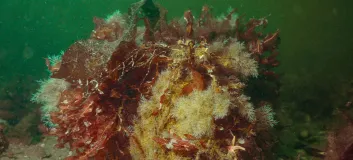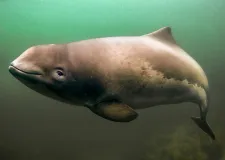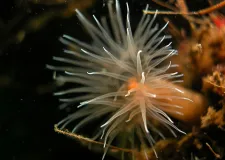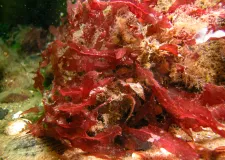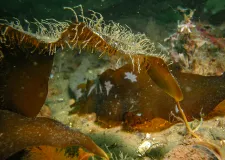Kadet Trench NCA
Brief description
The Kadet Trench Nature Conservation Area (NCA), which is only about 100 km² in size, is located in the western Baltic Sea about 20 km north of Rostock and about 10 km west of the Darss Peninsula. The Kadet Trench is actually a system of several trenches that cut into the Darss Sill submarine glacial till ridge at depths of up to 32 m. This trench system accounts for most of the water exchange between the western and central Baltic Sea. The western Baltic Sea is influenced to an even greater extent by the irregular saltwater inflows from the North Sea and these strong fluctuations in salinity levels reach as far as the Kadet Trench. For certain benthic species (such as the common starfish), this constitutes the eastern limit of their distribution range.
Rocky reefs of high conservation value are located at the centre of the NCA and a sandbank lies at its western boundary. Sand and silty sediments are characteristic of the seabed in the north and south. Despite its small size, the protected area thus provides an astonishing variety of different habitat types. The Kadet Trench NCA also has an important function as a migration corridor for harbour porpoises.
Pressures and management
Like the Baltic Sea overall, the protected area suffers from eutrophication and rising water temperatures caused by climate change. These effects are already being felt in the ecological communities.
Around 90 percent of the Kadet Trench NCA overlaps with one of the main shipping traffic separation schemes in the Baltic Sea. The mean ship traffic density is between 30 and 40 vessels per km2 per day, making it one of the busiest shipping routes in Europe. Due its depth, large container ships with very deep draughts pass through the trench, and it is also used by ferries. The heavy shipping traffic has a negative impact on harbour porpoises especially, which are highly sensitive to underwater noise. Seabirds that are sensitive to disturbance – such as divers and various sea ducks – avoid these highly frequented areas even though they would find an abundance food there.
Rules governing shipping traffic can only be agreed and adopted at international level through the International Maritime Organisation (IMO). Potential protection measures could include a reduction in shipping noise by deploying quieter ship propulsion systems or by imposing speed restrictions at specific times or in specific areas.
Recreational fishing regulations were implemented when the legislation establishing the protected area came into effect. In the central part of the NCA, there is an area of about 30 km² that is closed to recreational fishing from 1 February to 31 May. Another area of about 40 km² is closed all year round. The important reef areas of high ecological value in the NCA are located in those zones.
Regulations on commercial fishing in the Kadet Trench NCA entered into force in November 2024 under a delegated act adopted by the European Commission. Mobile bottom-contact fishing is now prohibited in large sections of the NCA.
Protected area management aims overall to ensure the survival and reproduction of the species and habitats listed in the Birds and Habitats directives through measures to prevent adverse effects and implement restoration activities.
Facts and figures
| Name | Habitats Directive SAC | EU Code | Size |
|---|---|---|---|
| Kadet Trench | Habitats Directive SAC | DE 1339-301 | 100 km² |
| Species and habitats | Size or figures (2024) | |
|---|---|---|
| Protected benthic habitats/areas | Sandbanks | 2 km² |
| Reefs | 40.7 km² | |
| Species/number | Harbour porpoise (Phocoena phocoena) | Important migration and feeding area |
Character
The reefs in the NCA are of high ecological importance and have a key function as stepping stones. Their structural diversity provides for rich species diversity, including in fish. For harbour porpoises, the trench system has an important function as a migration corridor between the central Baltic Sea and the Belt Sea.
The boundary of the protected area, with water depths of 18 m to 32 m, was primarily determined based on the presence of the reefs habitat type. Several reefs stretch from the Darss Sill out into the trench proper. These reefs are of great importance for biodiversity in the Kadet Trench and serve as important stepping stones for the eastward spread of a number of different species. A characteristic feature is the growth of macroalgae and blue mussels (Mytilus edulis) on the boulder fields. At depths of up to 18 m, the rocky reefs are overgrown with brown algae, mainly sugar kelp (Laminaria saccharina). Red algae occur at depths of up to 24 m. This occurrence of macrophytes at such great depths is unusual for the southern Baltic Sea and requires good and consistent light and oxygen conditions.
The protected area owes much of its ecological value to the great structural diversity of the reefs with varied slopes and depths. This and the relatively high salinity in some areas enable colonisation by very species-rich benthic fauna, including a very large number of Red List species. These benthic communities demonstrate relatively high salinity tolerance and are able to cope with the fluctuating salinity levels. The favourable availability of food and the many spawning and hiding places make the NCA important for fish. The wide range of fish provides an attractive supply of food for marine mammals and for various seabirds, provided they are not driven away by shipping.
Studies recently conducted by the Federal Agency for Nature Conservation (BfN) identified a sandbank on the western boundary of the NCA with a characteristic community of mussels, worms and other microorganisms. The sandbank is part of a megaripple field that extends from Danish territorial waters into the German EEZ and, according to current knowledge, has crest spacings of up to 400 m and crest heights of up to 5 m. The sand gaper (Mya arenaria), a species of clam, is particularly common in the NCA.
Acoustic recordings confirm that harbour porpoise frequently visit the Kadet Trench. They regularly come to in the NCA and pass through the adjacent waters on their migrations to and from the central and western Baltic Sea.
Part of the population of the western Baltic Sea and the Belt Sea, estimated to be no more than 14,000 individuals, migrate with their calves further into more eastern waters in the spring and then return to the western parts of the NCA from November.
Following a wide range of nature conservation measures, the grey seal population is finally growing again on the German Baltic Sea coast. The abundance of fish in the Kadet Trench system also serves seals observed in the NCA.
